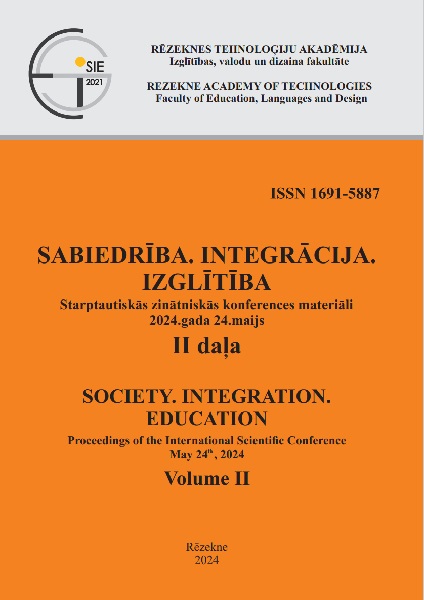AIM AND MEANING OF BREATHING EXERCISES: INTERDISCIPLINARY LITERATURE REVIEW
DOI:
https://doi.org/10.17770/sie2024vol2.7876Keywords:
breathing exercises, meaning of breathing exercises, classification of breathing exercisesAbstract
Respiration is an indispensable aspect of life that significantly influences both the physical and mental well-being of individuals, depending on such factors as depth and rhythm. Exploring the distinctions between chest and abdominal breathing is crucial for understanding their profound impacts, and embracing appropriate breathing exercises has proven to be advantageous for short-term relief and long-term holistic health. While acknowledged for diverse therapeutic applications, such as mitigating vocal cord fatigue, a comprehensive exploration of breathing exercises remains essential. Sport scientists and coaches are encouraged to acquire a set of breathing exercises for future implementation in the training routines. This study strives to conduct an interdisciplinary literature review to shed light on the aims, meaning, and classification of breathing exercises. Employing a literature review methodology, were analysed peer-reviewed articles from PubMed and ScienceDirect published during the years from 2000 to 2023, focusing on such keywords as breathing exercises, deep breathing, nasal breathing, abdominal breathing, thoracic breathing, pursed-lip breathing, breathing control, and respiratory muscle training. The research findings illustrate the multifaceted definitions, components, aims, and classifications of breathing exercises. This study establishes a foundation for identifying distinct subtypes, contributing to a more nuanced understanding of the significance and purpose of breathing exercises in enhancing overall well-being.
References
Anderson, B.E., Bliven, K.C.H. (2017). The Use of Breathing Exercises in the Treatment of Chronic, Nonspecific Low Back Pain. The Journal of Sport Rehabilitation, 26, 452–458. DOI:10.1123/jsr.2015-0199
Betka, S., Adler, D., Similowski, T., Blanke, O. (2022). Breathing control, brain, and bodily self-consciousness: Toward immersive digiceuticals to alleviate respiratory suffering. Biological Psychology, 171, 108329. DOI: 10.1016/j.biopsycho.2022.108329
Bruton, A., Garrod, R., Thomas, M. (2011). Respiratory physiotherapy: towards a clearer definition of terminology. Physiotherapy, 97(4), 345-349. DOI:10.1016/j.physio.2010.12.005
Cecins, N. M., Jenkins, S. C., Pengelley, J., & Ryan, G. (1999). The active cycle of breathing techniques-to tip or not to tip? Respiratory medicine, 93(9), 660–665. https://doi.org/10.1016/s0954-6111(99)90107-5
Chris, G. (2014). Recognizing and Treating Breathing Disorders. Auckland, New Zealand. Churchill Livingstone.
Csepregi, E., Gyurcsik, Z., Veres-Balajti, I., Nagy, A.C., Szekanecz, Z., Szántó. S. (2022). Effects of Classical Breathing Exercises on Posture, Spinal and Chest Mobility among Female University Students Compared to Currently Popular Training Programs. International Journal of Environmental Research and Public Health, 19(6), 3728. DOI: 10.3390/ijerph19063728
Fink, J. B. (2007). Forced expiratory technique, directed cough, and autogenic drainage. Respiratory Care, 52(9),1210–1221. DOI: 10.1155/2016/9717489
Gilbert, C., Chaitow, L., Bradley, D. (2014). Recognizing and Treating Breathing Disorders. Auckland, New Zealand. Churchill Livingstone.
Hamasaki, H. (2020). Effects of Diaphragmatic Breathing on Health: A Narrative Review. Medicines (Basel, Switzerland), 7(10), 65. https://doi.org/10.3390/medicines7100065
John, D. N., Hieu, D. (2023). Pursed-lip Breathing. USA, Florida, Stat Pearls Publishing.
Laís, S.V., Celso, R.F.C., Alex, H., Mandy, J. (2019). Dysfunctional breathing: what do we know? The Brazilian Journal of Pulmonology, 45(1), e20170347. DOI: 10.1590/1806-3713/e20170347
Maker-Clark, M. G. (2012). Integrative Medicine (Third Edition). USA, Madison. Saunders.
Medicines, 7(10), 65. DOI: 10.3390/medicines7100065
Nguyen, J.D. & Duong, H. (2023). Pursed-lip Breathing. USA, Florida, Stat Pearls Publishing.
Pardy, R. L., Reid, W. D., Belman, M. J. (1988). Respiratory muscle training. Clinics in Chest Medicine, 9(2), 287-96. PMID: 3292128 Retrieved from: https://pubmed.ncbi.nlm.nih.gov/3292128/
Pereira, M.C., Dacha S., Testelmans, D., Gosselink, R., Langer, D. (2019). Assessing the effects of inspiratory muscle training in a patient with unilateral diaphragm dysfunction. Breathe, 15(2), e90-6. DOI.org/10.1016/S0272-5231(21)00505-0
Pryor, J.A, Prasad S.A. (2009). Physiotherapy techniques. In: Pryor JA, Prasad SA, editors. Physiotherapy for respiratory and cardiac problems: adults and paediatrics. 4th ed. Edinburgh: Churchill Livingstone. 134–217. DOI: 10.1016/j.physio.2010.12.005
Sam, R. S., Shelley, W.A. (2007). Pain Management. USA, Kansas City, Missouri. Wisconsin. CMI, Graphic World, and Electronic Publishing Services.
Settergren, G., Angdin, M., Astudillo, R., Gelinder, S., Liska, J., Lundberg, J. O., Weitzberg, E. (1998). Decreased pulmonary vascular resistance during nasal breathing: modulation by endogenous nitric oxide from the paranasal sinuses. Acta Physiologica Scandinavica, 163, 235-239. https://doi.org/10.1046/j.1365-201x.1998.00352.x
Tecklin, J.S. (2007). Airway Clearance Dysfunction. Physical Rehabilitation, 642-668. DOI.org/10.1016/B978-072160361-2.50027-2
Waldman, S.D. (2011). Pain Management. USA, Kansas City, Missouri. Wisconsin.Saunders.
Yiting, L., Zile, J., Wang, Y., Xuanlin, L., Yang, X. (2022). Breathing Exercises in the Treatment of COPD: An Overview of Systematic Reviews. International Journal of Chronic Obstructive Pulmonary Disease,17, 3075–3085. DOI: 10.2147/COPD.S385855






